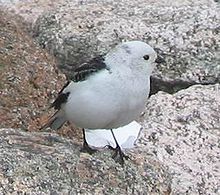Genus of birds
| Plectrophenax |
 |
| Snow bunting (Plectrophenax nivalis) |
Scientific classification  |
| Domain: | Eukaryota |
| Kingdom: | Animalia |
| Phylum: | Chordata |
| Class: | Aves |
| Order: | Passeriformes |
| Family: | Calcariidae |
| Genus: | Plectrophenax
Stejneger, 1882 |
| Type species |
Emberiza nivalis
Linnaeus, 1758 |
| Species |
| P. nivalis
P. hyperboreus |
Plectrophenax is a small genus of passerine birds of the longspur family Calcariidae.
Taxonomy
The genus Plectrophenax was introduced in 1882 by the Norwegian born zoologist Leonhard Stejneger with the snow bunting as the type species.[1] The name combines the Ancient Greek plēktron meaning "cock’s spur" with phenax meaning "imposter".[2]
Species
The genus contains two species, which may be conspecific.[3][4]
| Image | Scientific name | Common Name | Distribution |
 | Plectrophenax nivalis | Snow bunting | Arctic region, including the Cairngorms in central Scotland and the Saint Elias Mountains on the southern Alaska-Yukon border, as well as the Cape Breton Highlands |
 | Plectrophenax hyperboreus | McKay's bunting | Bering Sea, St. Matthew and Hall islands, and winters on the western coast of the U.S. state of Alaska |
They are high Arctic breeding seed-eating birds with stubby, conical bills, and much white in the plumage, especially in adult males. They nest in rock crevices. As would be expected, both species are highly migratory, wintering in more temperate areas.
The plumages are similar, but McKay's has more white and less black in the plumage, especially in the wings and tail. Adult breeding males of both species are mainly white with contrasting black on at least the wings, but are duller in winter. Females have white and brown plumage. The calls of both species are identical and include a low warbled hudidi feet feet feew hudidi feet feet feew hudidi.
References
- ^ Stejneger, Leonhard (1882). "On some generic and specific appellations of North American and European birds". Proceedings of the United States National Museum. 5 (261): 28–43 [33]. doi:10.5479/si.00963801.261.28.
- ^ Jobling, James A. (2010). The Helm Dictionary of Scientific Bird Names. London: Christopher Helm. p. 310. ISBN 978-1-4081-2501-4.
- ^ Gill, Frank; Donsker, David; Rasmussen, Pamela, eds. (August 2022). "Finches, euphonias, longspurs, Thrush-tanager". IOC World Bird List Version 12.2. International Ornithologists' Union. Retrieved 26 November 2022.
- ^ Withrow, J.J. (2020). "Plumage variation in Bering Sea Plectrophenax buntings and the specific status of McKay's bunting" (PDF). Western Field Ornithologists. 51 (3): 174–189.
|
|
|
|
|
|---|
| incertae sedis | |
|---|
| Agelaiinae | |
|---|
| Amblycercinae | |
|---|
| Cassicinae | |
|---|
| Dolichonychinae | |
|---|
| Icterinae | |
|---|
| Sturnellinae | |
|---|
| Xanthocephalinae | |
|---|
|
|
|
|---|
| Catamblyrhynchinae | |
|---|
| Charitospizinae | |
|---|
| Coerebinae | |
|---|
| Dacninae | |
|---|
| Diglossinae | |
|---|
| Emberizoidinae | |
|---|
| Hemithraupinae | |
|---|
| Nemosiinae | |
|---|
| Orchesticinae | |
|---|
| Poospizinae | |
|---|
| Porphyrospizinae | |
|---|
| Saltatorinae | |
|---|
| Sporophilinae | |
|---|
| Tachyphoninae | |
|---|
| Thraupinae | |
|---|
|
|
Taxon identifiers |
|---|
| Plectrophenax | |
|---|
Authority control databases: National  | |
|---|













